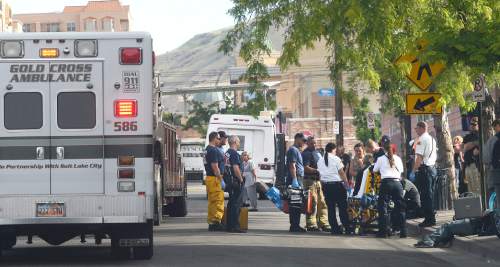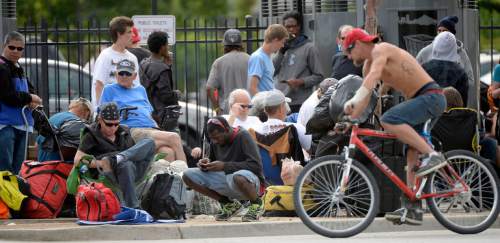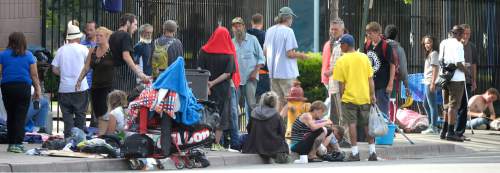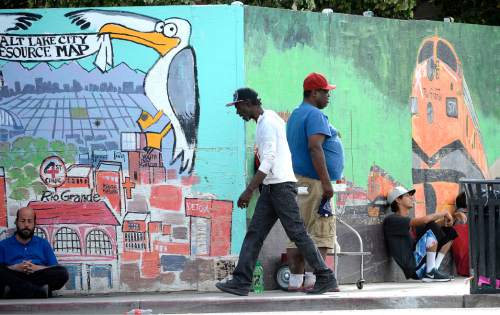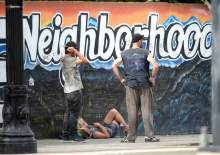This is an archived article that was published on sltrib.com in 2016, and information in the article may be outdated. It is provided only for personal research purposes and may not be reprinted.
While community leaders work out details for new homeless shelters and a more organized approach to delivery of services, the challenges in the Rio Grande district downtown continue to fester and boil over.
In the past year, Salt Lake City, Salt Lake County, service providers and community leaders have come together like never before to find long-term solutions to homelessness.
But residents, business owners and homeless people continue to send up warning flags regarding day-to-day life in the Pioneer Park area. Drug dealing, violence, prostitution and other tell-tale signs — such as human waste left on private and public property — send a clear message that things are not improving.
There is a greater police presence in the area than a year ago, and it may be curbing some violence. But the flow of drugs remains unabated. Heroin and substances such as spice are out in the open, and 500 West near 200 South is seen by law enforcement as ground zero for drug dealing along the Wasatch Front and beyond. Jason Mathis of the Downtown Alliance business group, which often promotes the capital's revving economy, quotes Dickens: "It was the best of times, it was the worst of times."
The organized effort to find long-term solutions, such as housing, treatment, counseling and tracking of outcomes is promising, he said.
The city and county sought $27 million from the Utah Legislature earlier this year. Lawmakers approved $9.2 million — $4.7 million will go to new facilities and $4.5 million will go to services. City and county officials are hopeful that similar amounts will be funded in the 2017 and 2018 legislative sessions.
Also on the upside, the Midvale shelter opened year-round for families and houses 300 people in a safe setting. Another new program allows homeless people to store their belongings downtown so they can search for work. And the Clean Team, people who are homeless or recently homeless, are employed to keep the area clean.
—
Out of control • Nonetheless, the situation in the Rio Grande neighborhood seems beyond control, Mathis said. "It's a crisis now, we need all hands on deck."
Last year, the Salt Lake City Council funded more police and Mathis said a shortage of cops is no longer a problem in the neighborhood. But, he added, there is limited space at the Salt Lake County Jail and many offenders go unpunished.
Pete Henderson, who owns and operates the Rio Grande Cafe, less than a block away from The Road Home shelter, said he is at his wits' end.
"It's at least as bad as last year," he said. "Probably worse."
This past year, the cafe served 35,000 fewer meals than it did in 2010, Henderson said.
"I'm very discouraged. That's the kindest word I can use," he said. "I really think this is going south."
Recently, a man who appeared to be homeless entered his cafe and "began hassling customers," he said. When his son asked him to leave, the man punched the younger Henderson in the face.
The open-air drug market just yards from his cafe is "shameful," the cafe proprietor said.
"It is causing a lack of accountability in my neighborhood. You have people sitting on the curb smoking crack," Henderson said. "What kind of city would operate like that?"
—
Treatment, help • Deputy Police Chief Josh Scharman said the situation around The Road Home shelter at 200 S. Rio Grande St. is "overwhelming" and needs more than a public safety solution. It will require treatment for the mentally ill and drug addicts, as well as more permanent housing.
Adding to the problem, he said, is that some people hanging out in the area are not homeless; they go there for drugs or to socialize.
"It's almost become like a social place," Scharman said. "People who have transitioned into housing come back because that's their social network."
Last year, the council budgeted for eight social workers to aid cops guiding homeless people to services, including mental-health providers. Five social workers have now been hired, Scharman said, and are working with police at the Community Connection Center, 511 W. 200 South. They provide outreach to help people get treatment for mental illness, drug addiction and other needs.
In addition, the department will add five bicycle patrols in the near future.
The police are doing an effective job, he said, but they are at capacity, as are social-service providers and the county jail. "Demand is exceeding supply."
A woman staying at the homeless shelter who identified herself only as Laura said violence continues around The Road Home, although it may be down from last year.
"There is a lot of violence with drugs," she said. "Most of them are good people here. But there are a lot of dope fiends."
She said she isn't "anti-cop," but at times the police presence is frightening, she said. "When they pull in here three cars deep, they aren't protecting me, that's intimidation."
Many officers, particularly on morning patrol, get to know people and try to help them, Laura said.
But others, particularly at night, are not liked, she said, describing them with an expletive.
Among the challenges, she said there isn't enough shade for people waiting to get a bed at The Road Home and they suffer in the heat. Residents must leave the shelter every morning and cannot return until evening.
—
Nothing easy • Homelessness is a multi-faceted problem with no easy fix, lamented Councilwoman Lisa Adams. She, too, is frustrated and sympathizes with residents and business owners in the area, as well as the people seeking services.
"The model we have now is not working," Adams said. "It creates huge problems in the area."
The council is set to pass its annual budget Tuesday and has set aside $580,000 for immediate needs in the Rio Grande area. But it has yet to specify how the funds should be spent. Last week, the council set aside an additional $200,000 for potties on trailers in an attempt to deal with the human-waste problem.
"The Road Home has to be a better neighborhood," Adams said. "But no neighborhood can absorb an additional 1,200 people per night."
A spokesman for Mayor Jackie Biskupski said her administration will use the money to mitigate impacts on businesses, residents and homeless people.
"We are focused on system reform," said David Litvack, the mayor's deputy chief of staff. "But we are not doing that in neglect of what is happening today."
The administration will bolster the Community Action Team — a multidisciplinary organization — that seeks to relieve issues rapidly, including outreach to help people get the services they need, Litvack said.
Nonetheless, a long, hot summer has just begun, and it has the makings of a challenging time in the Rio Grande area.


